Last updated on
Discover the possibilities and benefits of installing laminate flooring in your kitchen to achieve a stylish and durable surface for daily use.
The kitchen is the heart of any home, and it’s no wonder that homeowners are always looking for ways to make it more beautiful and functional. One popular option for updating your kitchen flooring is laminate.
Laminate flooring has come a long way in recent years and is now available in a wide range of styles, colors, and patterns. But before you rush out to buy some laminate planks, you may be wondering: can I put laminate flooring in the kitchen? In this article, we’ll explore this question in depth so that you can make an informed decision about whether or not laminate flooring is the right choice for your kitchen renovation project.
What's Inside
Types of Laminate Flooring

The most common type is known as high-pressure laminate (HPL), which is made by fusing multiple layers of paper and resin under high pressure. HPL is highly durable and resistant to scratches, stains, and wear.
Another type of laminate flooring that’s gaining popularity in recent years is luxury vinyl plank (LVP) or luxury vinyl tile (LVT). LVP/LVT mimics the look of natural materials like wood or stone but with added durability thanks to its synthetic construction.
There’s direct pressure laminate (DPL), which uses a single layer of paper fused directly onto the core board. DPL tends to be less expensive than HPL but also less durable.
Advantages of Laminate Flooring

One of the biggest advantages of laminate flooring is its affordability. Laminate can mimic the look and feel of more expensive materials like hardwood, tile, or natural stone at a fraction of the cost.
Another advantage is that it’s easy to install. Most laminate planks come with an interlocking system that makes installation quick and straightforward, even for DIY enthusiasts.
In addition to being affordable and easy to install, laminate flooring also offers excellent durability against scratches and dents compared with other types of floorings such as hardwood or vinyl plank floors. This makes it ideal for high-traffic areas like kitchens where spills are common occurrences.
Moreover, modern laminates have improved water resistance capabilities which make them suitable in areas prone to moisture such as bathrooms or laundry rooms; however caution should be taken when installing them in wet environments since they are not completely waterproof.
Pros of Installing Laminate Flooring in Kitchen

There are many advantages to installing laminate flooring in your kitchen, including its affordability, durability, and ease of maintenance.
One of the biggest pros of laminate flooring is that it’s aesthetically pleasing. Laminate can mimic the look and feel of natural materials like hardwood or stone at a fraction of the cost.
This means you can achieve an upscale look in your kitchen without spending a fortune.
Another advantage is that laminate flooring is cheaper than tile or natural stone options. It’s also generally less defective than other types of hard surface floors because it’s manufactured under controlled conditions with fewer defects.
Durability and maintenance are two more benefits worth mentioning when considering installing laminate in your kitchen. Laminate has scratch-resistant properties which make it ideal for high traffic areas such as kitchens where spills may occur frequently.
Most laminates have warranties ranging from 10-30 years depending on quality level which makes them long-lasting investments.
It’s Aesthetically Pleasing
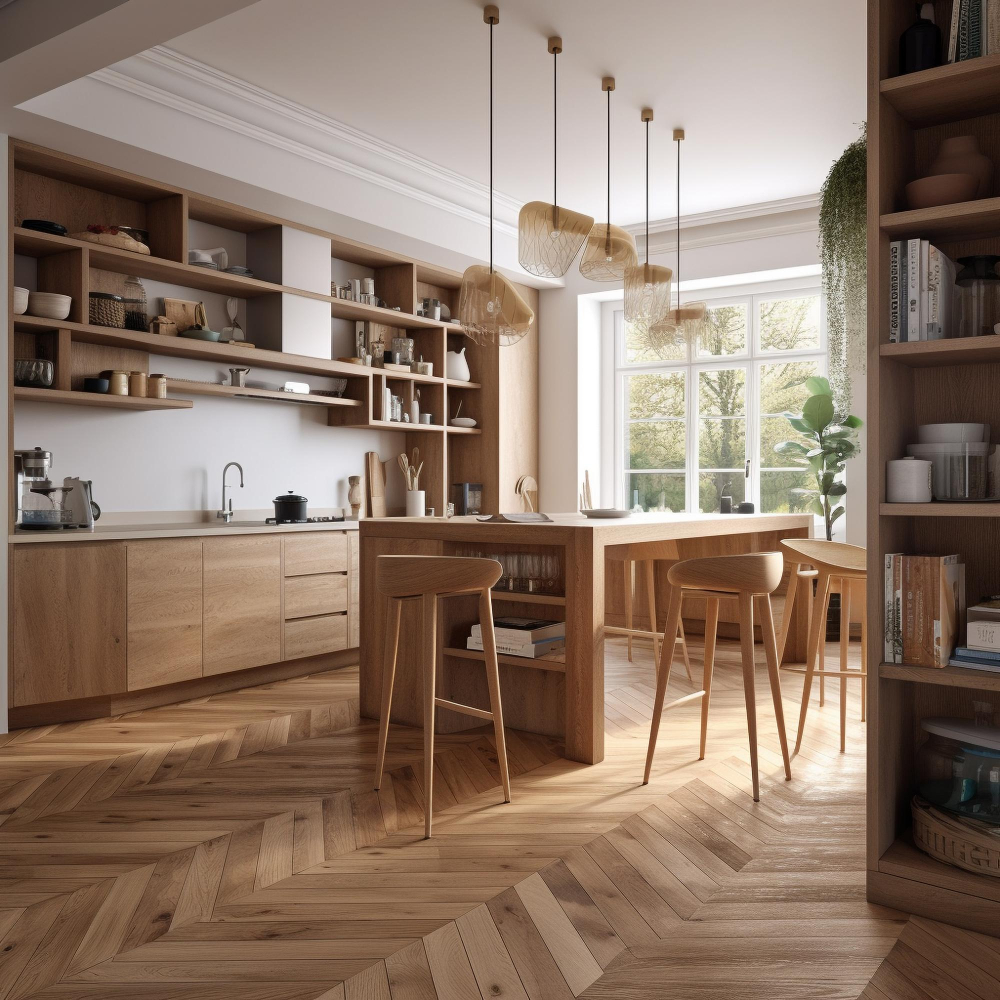
One of the biggest advantages of laminate flooring is that it’s available in a wide range of styles, colors, and patterns. This means that you can find laminate planks that mimic the look and feel of natural materials like wood or stone at a fraction of their cost.
In terms of aesthetics, laminate flooring has come a long way since its inception. Modern technology allows manufacturers to create realistic textures and finishes on each plank so that they closely resemble real wood or stone floors.
Many laminates have beveled edges which give them an even more authentic appearance.
It’s Cheaper Than Tile and Natural Stone

Compared to natural stone or tile, laminate flooring is significantly cheaper and can save you a lot of money on your renovation project. Laminate planks are easy to install, which means that you won’t have to spend a lot of money on professional installation services.
Another advantage of choosing laminate over natural stone or tile is that it’s much easier and less expensive to maintain in the long run. Natural stone requires regular sealing and polishing, while tiles need grout cleaning every so often.
Laminate flooring only needs occasional sweeping and mopping with mild soap water.
Generally Less Defects

This is because laminate planks are manufactured in a controlled environment, which means that they are less likely to have imperfections such as knots or cracks. The printing process used to create the design layer on top of the plank ensures consistency in color and pattern.
This makes laminate an excellent choice for homeowners who want a uniform look throughout their kitchen without any distracting blemishes or variations. It’s also worth noting that while natural wood floors can be beautiful, they often come with inherent flaws like warping and cupping due to changes in humidity levels over time.
Durability and Maintenance
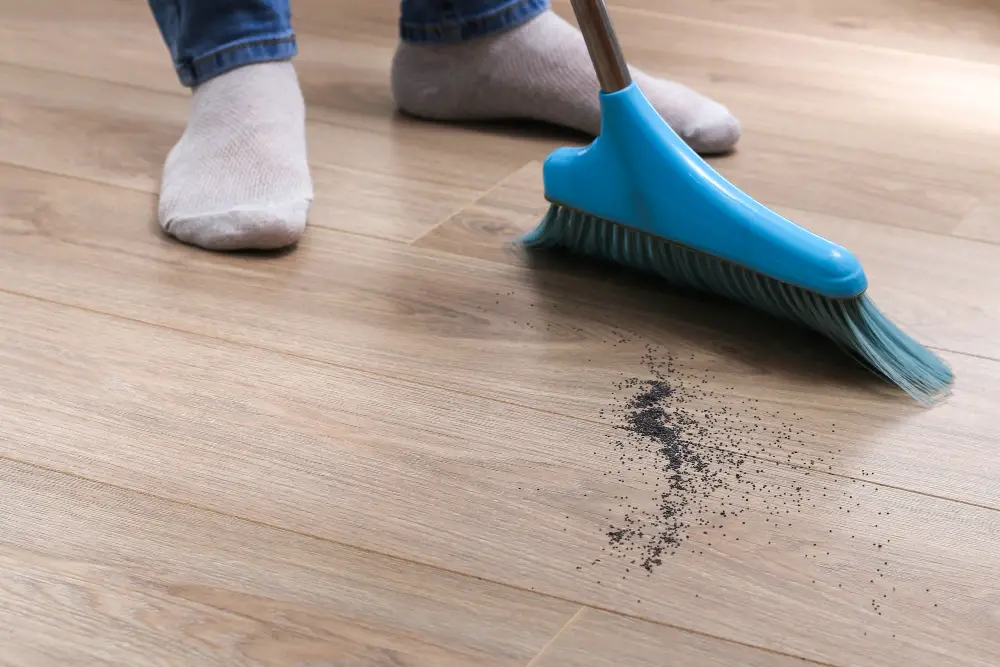
Laminate floors are made from multiple layers that are fused together under high pressure, making them resistant to scratches, dents, and stains. This makes it an ideal choice for high-traffic areas like kitchens where spills and messes are common.
To keep your laminate flooring looking great for years to come, regular maintenance is key. Sweep or vacuum regularly to remove dirt and debris that can scratch the surface over time.
For deeper cleaning, use a damp mop with a mild cleaner specifically designed for laminate floors.
It’s important not to oversaturate the floor when mopping as excess water can seep into the seams between planks causing damage over time. Additionally avoid using abrasive cleaners or tools such as steel wool pads which can also cause damage.
Laminate Flooring Scratch Resistance

It’s made up of several layers, including a wear layer that protects against scratches and scuffs. This top layer is usually made from aluminum oxide or melamine resin, which are both highly resistant to damage.
However, it’s important to note that while laminate flooring is scratch-resistant, it’s not completely scratch-proof. Heavy furniture or sharp objects can still leave marks on the surface if they’re dragged across the floor without proper protection.
To minimize the risk of scratches on your laminate kitchen floor, consider using felt pads under furniture legs and avoid dragging heavy items across the surface. You can also use area rugs in high-traffic areas to protect against wear and tear.
Laminate flooring offers excellent scratch resistance compared to other types of flooring materials like hardwood or tile.
Laminate Flooring Lifespan

One of the most significant advantages of laminate flooring is its lifespan. On average, laminate flooring can last anywhere from 15 to 25 years with proper care and maintenance.
The lifespan of your laminate floor will depend on several factors, including the quality of materials used in manufacturing it and how well you take care of it over time. High-quality laminates are more durable than lower-end options because they have thicker wear layers that protect against scratches, dents, and other types of damage.
To extend your laminate’s life span even further, be sure to follow manufacturer recommendations for cleaning and maintenance. Avoid using harsh chemicals or abrasive tools that could scratch or damage the surface layer.
Water Resistance
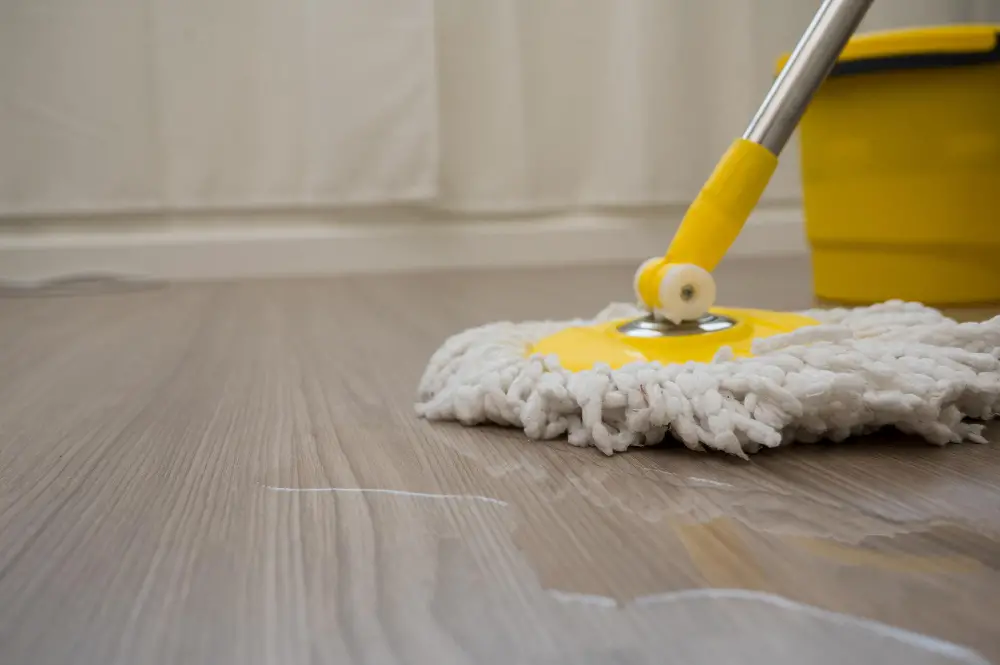
While laminate flooring is generally more water-resistant than hardwood, it’s not completely waterproof. This means that if you spill something on your floor or there’s a leak in your kitchen, the moisture can seep into the seams between planks and cause damage over time.
However, many modern laminates come with features like waxed edges and special coatings that make them more resistant to moisture. Some manufacturers even offer waterproof options specifically designed for use in kitchens and bathrooms.
It’s important to note that while these features can help protect against minor spills or splashes, they won’t necessarily prevent damage from major flooding or standing water. In those cases, you’ll need to act quickly by drying up any excess liquid as soon as possible.
Water Damage to Laminate Flooring

Kitchens are high-traffic areas that are prone to spills and splashes, which can cause serious damage to some types of flooring. While laminate is more water-resistant than hardwood or carpeting, it’s not completely waterproof.
If you spill something on your laminate floor and don’t clean it up right away, the liquid can seep into the seams between planks and cause swelling or warping. Over time, this can lead to permanent damage that requires replacement of affected planks.
It’s important to note that there are different levels of water resistance when it comes to laminate flooring. Some laminates have a higher level of protection against moisture than others do.
If you’re considering installing laminate in your kitchen, be sure to choose a product with good water resistance ratings.
Water Topical Vs. Casualty Events

While laminate flooring is generally resistant to moisture, it’s important to understand that there are different types of water exposure that can affect your floors differently.
Water topical events refer to spills or splashes on the surface of your floor. These types of incidents are usually minor and can be easily cleaned up with a damp cloth or mop without causing any lasting damage.
On the other hand, casualty events involve larger amounts of water such as flooding from a burst pipe or appliance malfunction. In these situations, even if you have installed waterproofing measures like sealing edges and using underlayment with vapor barrier properties; prolonged exposure may cause swelling at joints leading eventually lead them apart.
Laminate’s Core: Limited Water Resistance

While modern laminates are designed to be more water-resistant than ever before, they still have a core made from high-density fiberboard (HDF) or medium-density fiberboard (MDF), which can swell and warp when exposed to moisture for an extended period.
This means that if you spill any liquids on your laminate floor, it’s essential to clean them up immediately. Even small amounts of standing water can seep into the seams between planks and cause damage over time.
To minimize this risk, some manufacturers offer waterproof or highly water-resistant laminates with specially treated cores that resist swelling even when exposed to moisture. However, these products tend to be more expensive than standard laminates and may not be necessary unless you expect frequent spills or live in an area with high humidity levels.
Sealing Laminate’s Edges
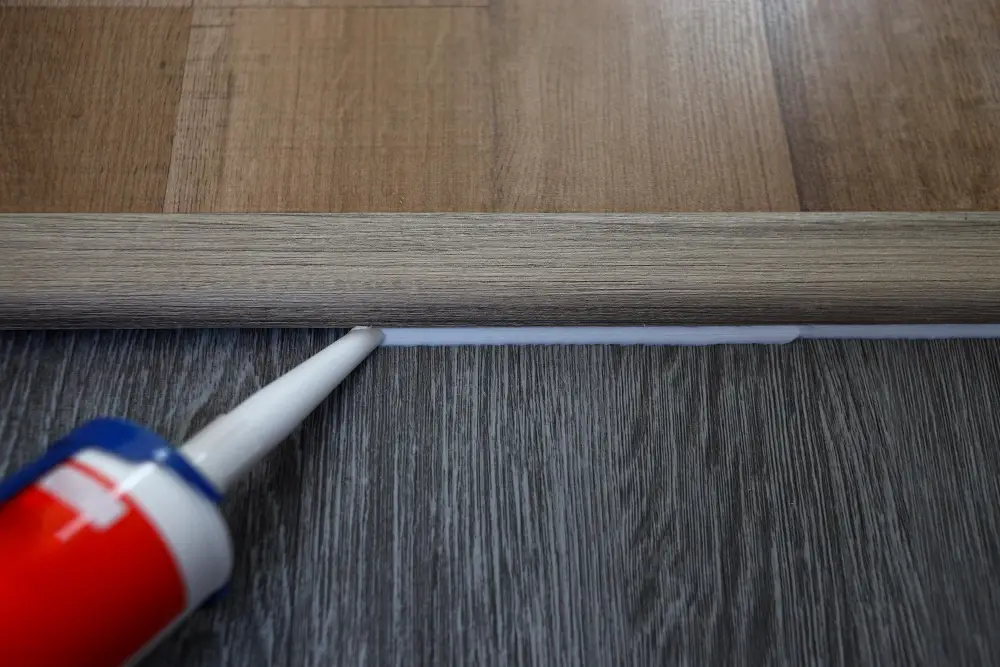
While laminate flooring is generally water-resistant, it can still be damaged by moisture if it seeps into the seams between planks. To prevent this from happening, you’ll need to use a special type of adhesive tape or sealant designed specifically for use with laminate flooring.
There are two main types of edge sealing products available: adhesive tape and silicone caulk. Adhesive tape is easy to apply and provides a strong bond between planks, but it may not be as effective at preventing moisture from penetrating the seams as silicone caulk.
Silicone caulk creates a waterproof barrier that helps keep moisture out while also providing additional support for the edges of each plank. However, applying silicone caulk requires more time and effort than using adhesive tape since you’ll need to carefully apply it along each seam by hand.
Ultimately, whether you choose adhesive tape or silicone caulking will depend on your personal preference and budget constraints.
Disadvantages of Laminate Flooring
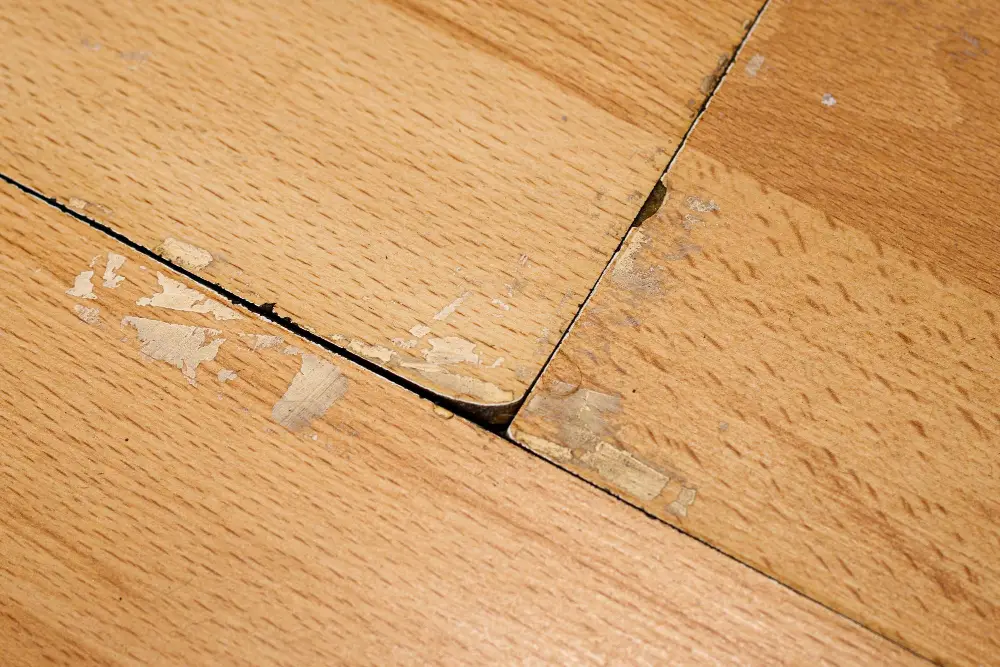
One of the biggest drawbacks of laminate flooring is that it can be easily damaged by moisture. While some types of laminate are marketed as water-resistant, they are not completely waterproof and can still suffer damage from prolonged exposure to moisture or standing water.
Another disadvantage is that once a section of your laminate floor becomes damaged or worn down, you cannot refinish it like you would with hardwood floors. Instead, you will need to replace the entire plank or section which could become costly over time.
Lastly, while laminates have come a long way in terms of eco-friendliness and sustainability practices during manufacturing processes; there may still be concerns about their environmental impact due to their synthetic nature and use in construction materials.
Cons of Installing Laminate Flooring in Kitchen

One of the main cons of installing laminate flooring in your kitchen is the possibility of moisture damage. While most laminates are water-resistant to some degree, they’re not completely waterproof like tile or natural stone.
This means that if you have a spill or leak in your kitchen, there’s a chance that water could seep into the seams between planks and cause damage over time.
Another disadvantage of laminate flooring is that it can’t be refinished like hardwood floors can. If your floor becomes scratched or damaged over time, you’ll need to replace individual planks rather than sanding and refinishing the entire surface as you would with hardwoods.
While laminate may be an affordable option compared to other types of flooring materials such as tile and natural stone; however when compared with vinyl plank which has similar durability characteristics but better resistance against moisture – this makes vinyl plank more suitable for kitchens where spills are common occurrences.
Possibility of Moisture Damage

One of the biggest concerns with installing laminate flooring in a kitchen is the possibility of moisture damage. Kitchens are high-traffic areas that are prone to spills and splashes, which can seep into the seams between planks and cause warping or swelling over time.
To minimize this risk, it’s essential to choose high-quality laminate flooring that has been specifically designed for use in kitchens or other moisture-prone areas. Look for products with water-resistant cores and edges that have been treated with sealant to prevent water from penetrating beneath the surface.
It’s also important to clean up spills as soon as they occur and avoid using excessive amounts of water when mopping your floors.
It Can’t Be Refinished

One significant disadvantage of laminate flooring is that it cannot be refinished. Unlike hardwood floors, which can be sanded down and refinished multiple times over their lifespan, once a laminate floor has been damaged or worn down, there’s no way to restore its original appearance.
This means that if you install a laminate floor in your kitchen and then accidentally drop a heavy pot or pan on it, leaving behind an unsightly scratch or dent – you’ll have no choice but to replace the affected planks entirely. While this may not seem like a big deal at first glance since individual planks can usually be easily removed and replaced without affecting the rest of the floor too much – keep in mind that finding matching replacement planks for older styles might prove difficult.
Eco-Friendliness

The good news is that many manufacturers are now producing laminate flooring with sustainability in mind. Some brands use recycled materials to create their products, while others have implemented more sustainable manufacturing processes.
Because laminate floors can last up to 20 years or more with proper care and maintenance, they don’t need to be replaced as often as other types of flooring. This means less waste going into landfills and fewer resources being used for production.
However, it’s important to note that not all laminates are created equal when it comes to eco-friendliness. Be sure to do your research before purchasing any type of laminate floor so that you can choose a product that aligns with your values and priorities.
If you’re considering installing new kitchen flooring but aren’t sure if laminate is the right choice for your home or lifestyle needs – weigh out its pros against cons carefully before making any decisions!
FAQ
Is it a good idea to put laminate flooring in the kitchen?
Yes, laminate flooring is a good idea for the kitchen due to its strength, stain and scratch resistance, and ability to provide comfort with underlayment for moisture and sound reduction.
Where should you not put laminate flooring?
Laminate flooring should not be installed in areas prone to moisture such as bathrooms, laundry rooms, saunas, enclosed porches, and anywhere that may require wet mopping.
Do kitchens need water-resistant laminate flooring?
Yes, kitchens need water-resistant laminate flooring as it is durable, easy to clean, and ideal for an area prone to staining and requiring daily cleaning.
What are the advantages and disadvantages of using laminate flooring in a kitchen?
Laminate flooring in a kitchen offers advantages such as durability and low cost, but it also has disadvantages like water sensitivity and potential surface damage.
Which type of laminate flooring is best suited for kitchen areas?
Water-resistant laminate flooring is best suited for kitchen areas.
How can proper installation and maintenance of laminate flooring improve its durability in a kitchen setting?
Proper installation and maintenance of laminate flooring in a kitchen setting can improve its durability by ensuring a resistant surface against wear, scratches, and moisture, protecting the structural integrity and appearance of the floor.




